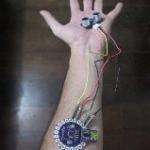Magnets, magnetizer and Surgical stainless steel/ Surgical steel
Hello everybody,i'm new in the community. I have some ideas about magnets, and if someone could help or share something, i will appreciate that.
I will start with this issue: Risks of corrosion, rust, contamination of magnets
My first idea is use surgical stainless steel, but this kind of material have weak magnetic properties, or none. But in counterpart all those those problems with safety could easily solved, huh?
I want to build a Magnetizer, to create those properties in this material and then use for implants reducing the risks.
Someone have a idea?
Anyone think this might work?
Thanx a lot people
P.S sorry about my english
Tagged:


Comments
But there is still risk using these magnet (Parylene, gold and nickel), is there a way to reduce that risk to zero?
I mean, somebody thinks this idea of using a magnetizer might work?
I think surgical steel may become a strong magnet. And you have the possibility to connect some eletronic devices to control or expanding the magnetic field, due the electric conductivity of human body and expanding the sensory field.
Thanx guys!
"I think surgical steel may become a strong magnet."
using surgical steel just won't work as it is austenite (gamma phase iron). it's paramagnetic, not ferromagnetic. so there is no way you can turn it into a magnet.
"And you have the possibility
to connect some eletronic devices to control or expanding the magnetic
field, due the electric conductivity of human body and expanding the
sensory field."
that sentence makes no physical sense.
my closest interpretation is that you ask for implanting an electronic device that does the same job as the magnets, just better. if so, yes, that's possible. and that would also give you thousands of times more sensivity. but this won't involve magnets or surgical steel anymore.
@ThomasEgi thanx pal, but we need to search more ways to reduce those risk, right?
I started this discussion exactly to know more about surgical steel and the possibility to magnetize them :) all i can say is thanks again for the answer
Sorry about my sentence, sorry about my english again. What i want to say is, if surgical steel was magnetic and theres no coating (plastics, or isolating things in them ), could be possible to apply some kind a current to maximize your magnetics capabilities ( with external source with some electronics/coils etc...)
Makes sense now?
Thats i'm said, any idea and answers will help.
Thanks everyone
P.S i really i want to build a magnetizer and try to magnetize stainless steel and surgical steel. I found in my research that 400 series of stainless is magnetic!!!
I think we could try to magnetize them, what we have to lose anyway?
that current-metal-electronic description makes no sense (in a physical way).
letting currents flow through your body over uninsulated conductors is a pretty dangerous, if not horribly deadly idea. and just sending current through a piece of steel won't magically improve any sensing capabilities.
"I think we could try to magnetize them, what we have to lose anyway?"
my guess would be: magnetic moment :D
Nice Thomas, thanks for the answers!! it's very elucidative!
I found this sites with some nice information about the magnetic properties of stailess steel ( series 400)
About 400 series Stainless steel:
http://www.wisegeek.com/is-stainless-steel-magnetic.htm
http://en.wikipedia.org/wiki/Stainless_steel#Comparison_of_standardized_steels (read about Martensitic like 400 series)
http://en.wikipedia.org/wiki/Martensitic_stainless_steel
http://www.ssina.com/faq/index.html ( they can explain take off our doubts about stainless)
i think the next step is see how this kind of stainless steel will behave after be magnetized into a magnetizer.
When i was saying about the current, i want to mean all those fun experiments that we learn with magnets and batteries :)
I think that will be fun do this kind of thing with the implants http://hacknmod.com/hack/magnetic-levitation-using-the-arduino/ off course, not now but in the early future :) i think this is not looking so dangerous now, huh?
Unfortunately the 400 series of stainless steel has the short time of corrosion than the other kinds of stainless steel. Now i'm going to know how long they can be in the human body.
Thanx dude!! really
I appreciated all answers and advices.
if you want to increase sensitivity then you can (as Ben noted) use magnetometers. those will only get you very low frequent fields tho. for higher frequencies you need to work with coils and a bit of analog circuitry. bit complex, but at least reasonably doable.